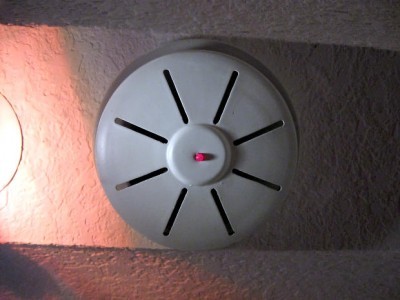Getting Started
Approximately 2,500 people are killed each year in residential fires and another 500 die from carbon monoxide, a colorless gas that’s known as the “silent killer.” Installing smoke and Co alarms throughout your home is the first step in staying safe.
Every home should have smoke alarms and CO alarms are a must in all homes with fuel-burning appliances such as a furnace, water heater, range, cooktop or grill. Even an all-electric home may benefit from a couple of Co alarms because using a generator during a blackout produces CO. You need alarms that detect flaming and smoldering fires for each bedroom, with at least one set on each level, including the attic and basement. You should also have a CO alarm on each living level, in the basement, and near (not inside) an attached garage. You can buy smoke and Co alarms at hardware and home- improvement stores and online. Smoke alarms are relatively inexpensive, starting at about $15 for basic models, Co alarms cost $35 and up. Check the package to make sure smoke alarms meet Underwriters Laboratories Standard 217 and CO alarms meet UL Standard 2034. Also look up the dat of manufacture on the back of the alarms, These devices lose their sensitivity over time, so the fresher, the better.
None Do It All
Smoke alarms that use ionization technology are great at detecting a fast, flaming fire such as burning paper, but poor at detecting a smoldering fire such as in a couch or mattress. The opposite is true of photoelectric smoke alarms. A few alarms combine ionization and photoelectric technologies to cover both types of fire, but not both. Our challenge to manufacturers: Produce a single device that sense for both types of fires and CO.
Strength In Numbers
Getting all of a home’s alarms to communicate with one another poses another hurdle.
Interconnected alarms all sound simultaneously when one is triggered. Thus, they can warn you of a fire or a CO leak in the basement when you are asleep upstairs. You can use adapters to connect hard-wired alarms, even those made by different manufacturers. But wireless alarms can communicate only with other wireless alarms of the same make, since manufacturers use different frequencies. The industry needs to fix that problem as well.
Do Your Homework
Before you shop, check your town’s or county’s regulations. Details such as types of alarms and placement differ from one jurisdiction to another. Also contact your insurance company. Some insurers offer a 5 percent discount for homes with smoke alarms.
Proper Installation and Maintenance Are Critical
Follow the instructions in the owner’s manuals. A few rules of thumb: Smoke rises, so mount smoke alarms on the ceiling or high on the wall. To avoid false alarms, don’t mount ionization smoke alarms in the kitchen, where burnt toast might set them off, or near sources of steam such as a bathroom, laundry room or sauna. Don’t install Co alarms in the kitchen or near any cooking appliance, in the garage, or near the furnace or water heater. Avoid breezy areas around fans, vents, air conditioners, doors and open windows, where fresh air can cause a misleadingly low Co reading. Keep Co alarms out of direct sunlight. Test smoke and CO alarms weekly and vacuum them monthly. Follow the manufacturer’s recommendations on battery replacement. Alarms have a limited useful life. Replace CO alarms every five years and smoke alarms revery ten years. In addition, prepare a plan of evacuation in case of fire or CO emergency, and have everyone in the family practise it like a fire drill every few months.
First Alert PC910 10-Year 2 in 1 Photoelectric Smoke Detector with Carbon Monoxide Alarm, White
Kidde KN-COPP-B-LPM Battery-Operated Carbon Monoxide Alarm with Digital Display



